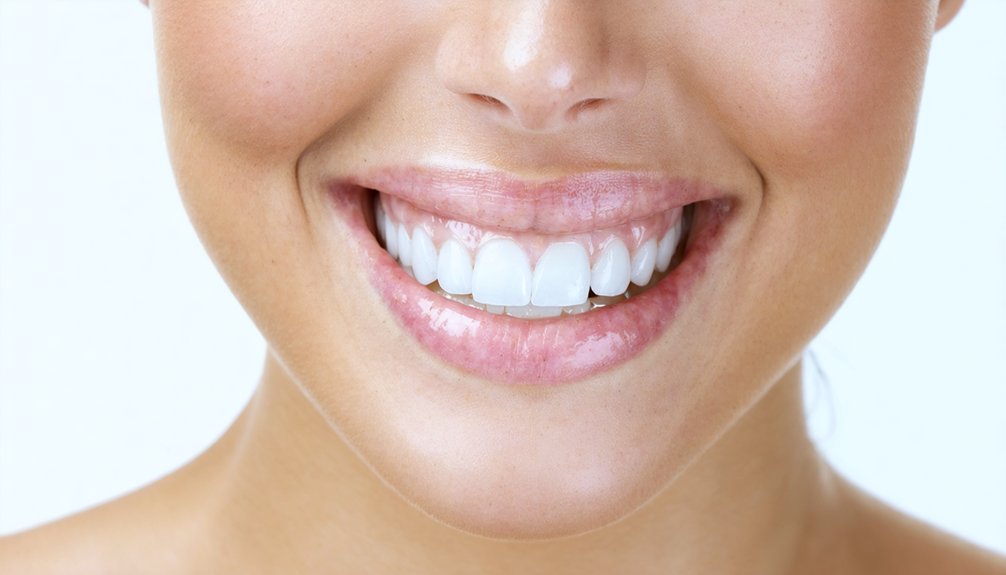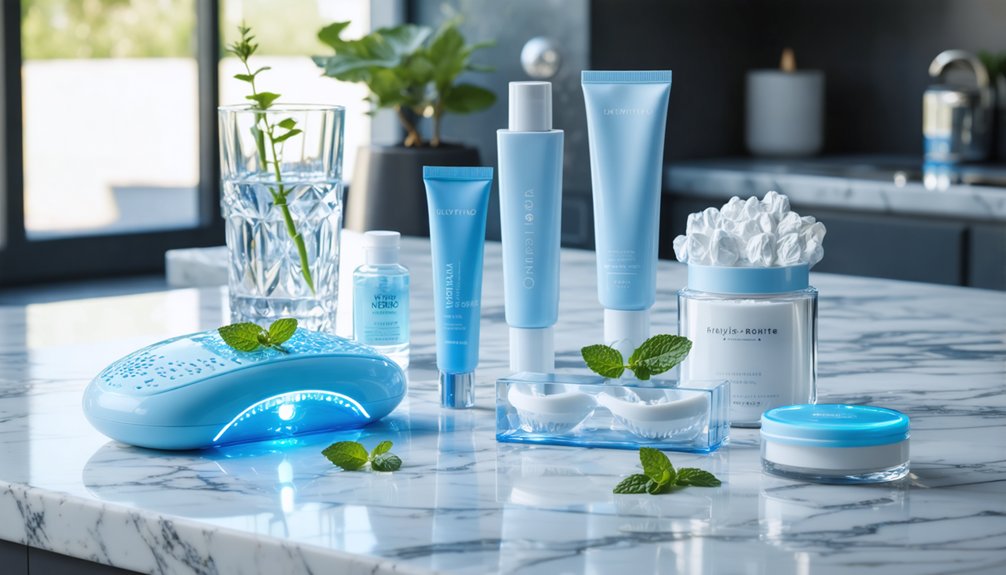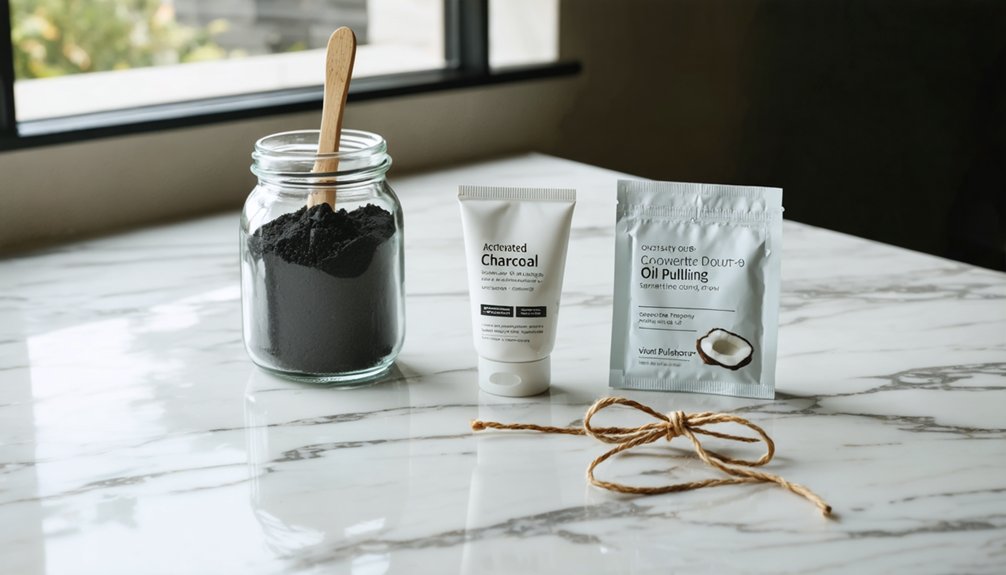If you have sensitive gums, you can safely whiten your teeth through professional treatments using custom-fit trays with low-concentration carbamide peroxide gels or gentle at-home methods like oil pulling and mild baking soda pastes. Start with desensitizing toothpaste 1-2 weeks before treatment, and consider protective barriers like petroleum jelly for sensitive areas. Professional oversight guarantees ideal results while minimizing irritation, and natural alternatives offer additional options for achieving a brighter smile.
Key Takeaways
- Professional whitening treatments with custom-fit trays and protective barriers minimize gum irritation while providing effective whitening results.
- Start with gentle natural methods like oil pulling or mild baking soda paste twice weekly before progressing to stronger treatments.
- Use desensitizing toothpaste for 1-2 weeks before whitening and apply protective petroleum jelly to gums during treatment.
- Choose lower-concentration carbamide peroxide gels with custom-fitted trays to ensure precise application and minimize gum exposure.
- Maintain good oral hygiene with soft-bristled brushes and non-abrasive toothpaste while avoiding staining foods and beverages.
Understanding Gum Sensitivity and Teeth Whitening
While teeth whitening has become increasingly popular for achieving a brighter smile, it’s vital to understand how these treatments can affect sensitive gums. The active ingredients in whitening products – hydrogen peroxide or carbamide peroxide – can cause significant gum irritation when they contact soft tissues. Most sensitivity symptoms typically resolve within two days after completing whitening treatment.
Your risk of sensitivity increases if you have pre-existing gum conditions like recession or periodontal disease. The peroxide concentration in over-the-counter products often leads to more severe reactions than professional treatments. Having treatments performed by a qualified dentist significantly reduces the risk of gum damage.
Professional teeth whitening treatments are safer for sensitive gums than over-the-counter options, especially if you have existing gum problems.
When these whitening agents penetrate beyond your tooth structure, they can trigger inflammation, burning sensations, and white spots on your gums. Your oral hygiene status also plays an important role – poor dental care can make your gums more vulnerable to chemical irritation.
Understanding these mechanisms helps you make informed decisions about whitening treatments that won’t compromise your gum health.
Professional Whitening Options for Sensitive Teeth and Gums
For patients with sensitive teeth and gums, professional whitening treatments offer carefully controlled options that minimize discomfort while achieving desired results.
Your dentist can customize treatment intensity through various approaches, including custom-fit trays with lower-concentration carbamide peroxide gels, modified in-office procedures, or laser-activated systems.
Custom tray treatments allow you to control whitening effectiveness by adjusting wear time at home, while in-office sessions can incorporate protective barriers and desensitizing agents. These treatments typically cost between $150 to $600 for custom tray options.
Laser whitening may achieve 7-10 shade improvements in fewer visits through controlled energy application.
Treatment duration varies based on sensitivity levels, with options ranging from multiple shorter sessions to gradual at-home approaches.
Professional supervision guarantees the integration of desensitizing elements like potassium nitrate or fluoride to protect sensitive tissues throughout the whitening process. Experts recommend waiting six months between treatments to maintain optimal oral health and prevent increased sensitivity.
Safe At-Home Whitening Methods for Sensitive Gums
When starting your at-home whitening journey with sensitive gums, you’ll want to begin with natural remedies like oil pulling and gentle baking soda pastes before progressing to more intensive treatments.
Custom-fitted trays offer precise control over whitening gel application and minimize gum exposure compared to one-size-fits-all solutions. Regular consumption of calcium-rich foods helps strengthen teeth and maintain gum health during the whitening process. Using products containing potassium nitrate can help reduce nerve sensitivity during whitening treatments.
You’ll achieve ideal results by using soft-bristled brushes with gentle, circular motions while avoiding aggressive scrubbing that can irritate sensitive gum tissue.
Natural Whitening Remedies First
Before pursuing more aggressive teeth whitening treatments, individuals with sensitive gums should explore natural remedies that minimize tissue irritation.
Start with a gentle baking soda paste, mixing pure baking soda with water and applying it no more than twice weekly. This provides mild stain removal without harsh abrasives or chemicals that could damage delicate gum tissue. Regular use requires caution since excessive baking soda can erode tooth enamel over time.
Oil pulling offers another gentle approach, using coconut or sesame oil swished for 15-20 minutes daily. While scientific evidence for whitening is limited, this technique helps reduce bacteria and plaque without irritating sensitive gums. Consuming high-fiber fruits and crunchy vegetables like apples and carrots can naturally help clean teeth while eating.
You’ll want to maintain these practices alongside regular brushing with a soft-bristled toothbrush and non-abrasive toothpaste formulated for sensitivity.
Remember to rinse thoroughly with water after consuming staining foods or beverages.
Custom-Fitted Tray Benefits
After exploring natural remedies, custom-fitted whitening trays represent the next level of safe, professional-grade teeth whitening for individuals with sensitive gums.
The key custom tray advantages stem from their personalized fit, which guarantees precise gel application and minimizes gum irritation common with over-the-counter options. Long-lasting whitening effects can be maintained for months to years with proper maintenance.
Studies show that forty million Americans use teeth whitening products, demonstrating the widespread desire for a brighter smile.
You’ll benefit from the trays’ exact molding to your dental arches, preventing gel leakage while enabling uniform coverage of bleaching agents across all tooth surfaces.
This controlled approach allows you to adjust treatment intensity based on your sensitivity levels. The customized design also accommodates irregular tooth alignment, guaranteeing even whitening in hard-to-reach areas.
With the flexibility to whiten at home on your schedule, you’ll achieve professional-quality results while maintaining peak gum health through gradual, controlled treatment sessions.
Gentle Brushing Techniques
Since maintaining healthy gums is essential during the whitening process, proper brushing techniques form the foundation of any successful teeth whitening regimen. Your gentle brushing technique directly impacts both plaque removal and gum sensitivity during whitening treatments.
- Position your soft-bristled toothbrush at a 45-degree angle against your gum line to effectively clean without causing irritation.
- Use gentle circular motions while applying minimal pressure to protect your enamel and prevent gum recession.
- Maintain consistent brushing habits, dedicating two minutes twice daily to thorough cleaning.
- Focus on systematic plaque removal by cleaning each tooth surface methodically, paying special attention to hard-to-reach areas.
Remember that aggressive brushing can increase sensitivity and compromise your whitening results, so always prioritize gentle, controlled movements during your oral care routine.
Natural Alternatives for Gentle Teeth Whitening
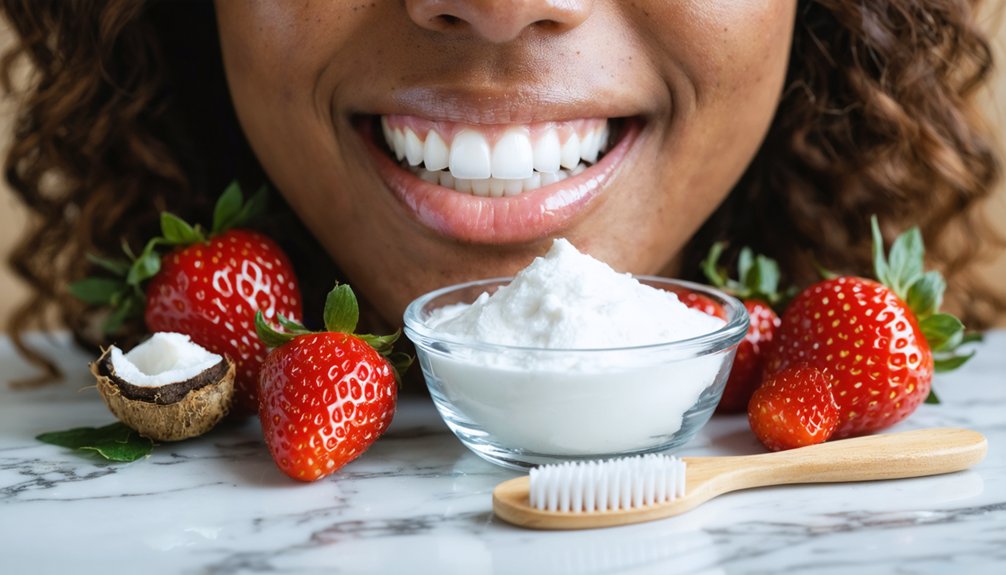
While professional teeth whitening treatments remain the most effective option, several natural alternatives offer gentler approaches for those with sensitive gums.
Baking soda benefits include its mild abrasive properties that can remove surface stains when mixed with water into a paste. Use it sparingly—once or twice weekly—to prevent enamel erosion. You can enhance its effectiveness by combining it with diluted hydrogen peroxide (3% or less), though be aware of hydrogen peroxide risks such as gum irritation and tooth sensitivity with prolonged use.
For an even gentler approach, consider oil pulling with coconut or sesame oil, which may reduce plaque buildup naturally.
Additionally, incorporating crunchy, high-fiber fruits and vegetables into your diet helps stimulate saliva production, naturally cleansing teeth while maintaining gum health.
Managing Discomfort During the Whitening Process
Managing tooth sensitivity and gum discomfort during whitening treatments requires a strategic combination of preventive measures and targeted interventions.
A balanced approach of prevention and targeted solutions is essential for managing sensitivity while pursuing a brighter smile.
When applying whitening gel, you’ll need to focus on careful placement and appropriate concentrations to minimize irritation. Effective pain relief techniques include using desensitizing toothpaste before treatment and maintaining proper intervals between sessions.
- Start using sensitivity toothpaste containing potassium nitrate or stannous fluoride 1-2 weeks before treatment
- Apply protective barriers like petroleum jelly to shield exposed roots and sensitive gum areas
- Implement saltwater rinses and alternating temperature compresses for immediate relief
- Modify your diet to room-temperature, non-acidic foods during treatment periods
For persistent discomfort, consider reducing whitening gel concentration or extending time between sessions.
Remember to pause treatment if you experience excessive sensitivity.
When to Seek Professional Dental Guidance
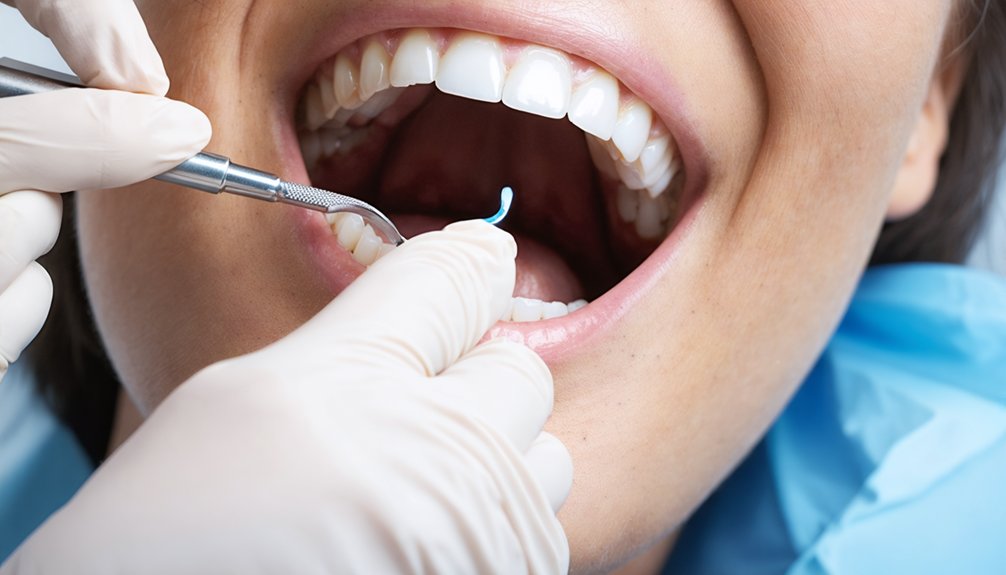
Understanding when to consult dental professionals for teeth whitening is essential for both safety and best results. You should seek a dental evaluation before starting any whitening treatment if you have severe tooth sensitivity, gum disease, active decay, or a history of allergic reactions to whitening agents.
Don’t hesitate to contact your dentist if you experience persistent tooth sensitivity, intense gum irritation, oral tissue damage, or unexpected tooth discoloration after whitening.
Certain whitening risks require professional oversight, particularly if you have thin enamel, existing dental restorations, or need multiple whitening sessions. Your dentist can provide tailored solution strengths, monitor your progress, and apply desensitizing treatments when necessary.
They’ll also guarantee proper application technique to protect your gum tissue and detect any underlying conditions that could complicate the whitening process.
Frequently Asked Questions
Can I Whiten My Teeth While Wearing Braces or Other Dental Appliances?
You’ll need your dentist’s approval for whitening with braces or appliances. They can recommend safe techniques that avoid damaging metal components while treating only exposed tooth surfaces.
How Long Should I Wait to Whiten Teeth After a Dental Filling?
90% of dentists recommend waiting 10-14 days after getting fillings before whitening your teeth. This whitening timeline allows proper bonding and minimizes dental sensitivity risks from peroxide-based treatments.
Will Whitening Treatments Affect the Color of Existing Dental Crowns?
No, your whitening treatments won’t change your crown color since crowns are made of non-porous materials. You’ll need to reflect on dental aesthetics carefully, as natural teeth may whiten while crowns remain unchanged.
Does Smoking Affect the Duration and Effectiveness of Teeth Whitening Results?
Yes, smoking effects severely reduce your whitening duration. You’ll experience faster staining, weaker results, and need more frequent touch-ups due to nicotine and tar deposits on your teeth’s surface.
Can Pregnancy or Nursing Impact the Safety of Teeth Whitening Treatments?
Want the safest approach during this special time? You shouldn’t undergo teeth whitening while pregnant due to pregnancy precautions, though nursing guidelines suggest it’s likely safe once you’re breastfeeding with doctor approval.
References
- https://www.redrocksfamilydentistry.com/teeth-whitening-options-for-sensitive-teeth/
- https://www.sensodyne.com/en-us/oral-health-tips/whitening-sensitive-teeth/what-to-know/
- https://www.culvercitydentist.com/blogs/teeth-whitening/best-teeth-whitening-options-for-people-with-sensitive-teeth
- https://www.goodrx.com/conditions/dental-care/sensitive-teeth-after-whitening
- https://www.suttonpda.com/sensitivity-safety-teeth-whitening/
- https://pmc.ncbi.nlm.nih.gov/articles/PMC4058574/
- https://www.nextleveldentalstudio.com/post/6-natural-ways-to-safely-try-teeth-whitening-for-sensitive-teeth
- https://www.txdentisttree.com/blog/teeth-whitening-for-sensitive-teeth-cip1800/
- https://www.drbobsdentalcare.com/is-teeth-whitening-safe-for-sensitive-teeth/
- https://maroubradentalavenue.com.au/what-is-the-link-between-teeth-whitening-and-gum-recession/
